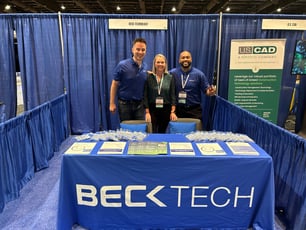What Does Diversity Look Like In Construction?
“Diversity” has become one of the biggest buzzwords in industries across the U.S. As people have become increasingly aware of the impact that diversity—or lack thereof—can have on workplace culture and satisfaction, companies have responded accordingly and have started to incorporate diversity into places like C-suite conversations and manager training. In fact, according to Indeed, job postings centered around “diversity, inclusion, and belonging” rose 123% between May of 2020 and March of 2021.
But that’s where things get a little confusing. Often, buzzwords or hot topics are thrown around so much that they begin to lose their meaning and drift into a vague, nebulous idea that has no real impact. What exactly do diversity and inclusion roles look like, and what benefit do they bring to your company? What do words like diversity and inclusion truly mean?
 Diversity isn't just about what you look like. It's also about different cultures, experiences, ages, and backgrounds.
Diversity isn't just about what you look like. It's also about different cultures, experiences, ages, and backgrounds.At its simplest, diversity just means “variety.” On a more complex level, diversity can refer to diversity of gender, ethnicity, thought, and even experience. That’s why diversity is usually followed by “inclusion” —companies want to cultivate a wide variety of perspectives in their workplaces, and they also want to make sure that employees feel that they work in a place where their perspective, whether common or uncommon, is valued rather than dismissed.
While these definitions provide some more clarity, they do not portray what diversity and inclusion looks like on a practical level. For a company who is just trying to make the world a better place and may not be equipped with all of the resources of a Fortune 500 behemoth, it can be overwhelming to try and incorporate something as conceptual as diversity. But never fear! That’s exactly why we’ve collected three of the best diversity initiatives happening now in the construction sector. Stay tuned until the end for a bonus.
- Messer: Supplier Diversity
- H.J. Russell: Diversity Manager for Construction & Program Management + Elevating Minority Business Enterprises
- Beck Technology: Diversity, Inclusion, and Belonging Series
Messer: Supplier Diversity
Headquartered in Cincinnati, Messer is a general contractor with offices throughout the Southeast and Midwest of the U.S, building projects in a variety of sectors that include federal/military, aviation, healthcare, and industrial. Messer has always been highly attuned to the needs of their employees—they became employee owned in 1990, they provide employees with opportunities to invest in their surrounding communities, and they hold “zero injury” as one of their core values.
 Elevating both minority and women-owned business enterprises are key to Messer's diversity initiatives.
Elevating both minority and women-owned business enterprises are key to Messer's diversity initiatives.So, it comes as no surprise that Messer was one of the first to model what a practical, successful diversity and belonging initiative looks like. They launched their Economic Inclusion initiative which focuses on increasing diversity in their business, workforce, and partnerships in measurable ways. Messer has increased financial investment in M/WBE (Minority/Women Business Enterprises) from $35 million in 2005 to $278 million in 2020, and they publish a quarterly newsletter spotlighting diverse subcontractors and suppliers. Additionally, Messer also lists the diverse construction management firms they partner with, some of which include Harmon Construction Incorporated and the Don Hardin Group.
H.J. Russell: Diversity Manager for Construction & Program Management + Elevating Minority Business Enterprises
H.J. Russell is a seventy-year-old, historically black-owned general contractor based out of Atlanta, Georgia. H.J. Russell offers both construction and program management services for several different sectors such as airport/transportation, sports and entertainment, multi-family and higher education.
Although H.J. Russell is a black-owned business, they realize that a culture that truly embodies diversity and inclusion is one that continues to maintain education and growth around diversity rather than stagnating. One of the most recent steps H.J. Russell has taken to ensure that their workplace remains welcoming to a variety of backgrounds and perspectives is promoting Claudette Hanks, former Field Office Coordinator, to Diversity Manager for Construction and Program Management.
CEO Michael B. Russell Sr. offers further insight in the announcement of Claudette’s new role: “I know many people think, we’re black-owned, so we don’t need to focus on diversity. That couldn’t be further from the truth. Our employee base is very diverse, and our legacy has always been to support, nurture, and elevate MBEs (Minority Business Enterprises), and we’ve done a fairly good job at it, but we want to do a great job.” We couldn’t agree more, and H.J. Russell’s dedication to outstanding success in every aspect of their company is an excellent example of passion and innovation.
Beck Technology: Diversity, Inclusion, and Belonging Series
Yes, we’re tooting our own horn for a moment. At Beck Technology, we’ve tackled diversity initiatives in two ways. First, we’ve incorporated measurable action items around diversity and inclusion as part of our company-wide objectives for each quarter of the year. These objectives help us determine the effectiveness of different strategies as well as pinpoint areas where we still need to grow.
Secondly, we’ve also launched the Diversity, Inclusion and Belonging Series, which is coincidentally hosted by our Diversity, Inclusion and Belonging (DIB) committee, which is comprised of leadership members as well as members from departments such as Sales, Marketing, Development, and Services. This series occurs every month as a one-hour video conference in which members of our company have the opportunity to speak about topics they are passionate about. Some of these presentations have included discussions about supporting those with mental disabilities, celebrating different cultural holidays, what it’s like to immigrate to the United States, and being an adoptive parent.
Both of these initiatives have been attainable yet impactful steps that we’ve taken towards making Beck Technology one of the best places to work for everyone. As we continue growing, we will also be introducing workshops and manager training to further cement the effectiveness of these existing initiatives.
Now That You Know WHAT Diversity Initiatives Look Like…WHY Is It Important?
Hopefully, the stories of our two clients and our own have given you a better idea of what actively embracing diversity and inclusion could look like at your company. However, understanding the practical application of diversity and inclusion doesn’t tell us why it’s important or the benefits that it brings. To understand that, it’s important to look at hard numbers and not just anecdotal experiences.
Global consulting firm McKinsey and Company discovered in a 2019 analysis that when companies scored in the top quartile for gender diversity on executive teams, they were 25 percent more likely to “have above-average profitability than companies in the fourth quartile.” Additionally, companies who were in the top quartile for ethnic and cultural diversity outperformed those in the fourth by 36 percent when it came to profitability. Increasing focus on diversity isn’t just about making your employees happier—it has tangible ROI for you and your team.

-1.png?width=112&height=112&name=image%20(4)-1.png)














